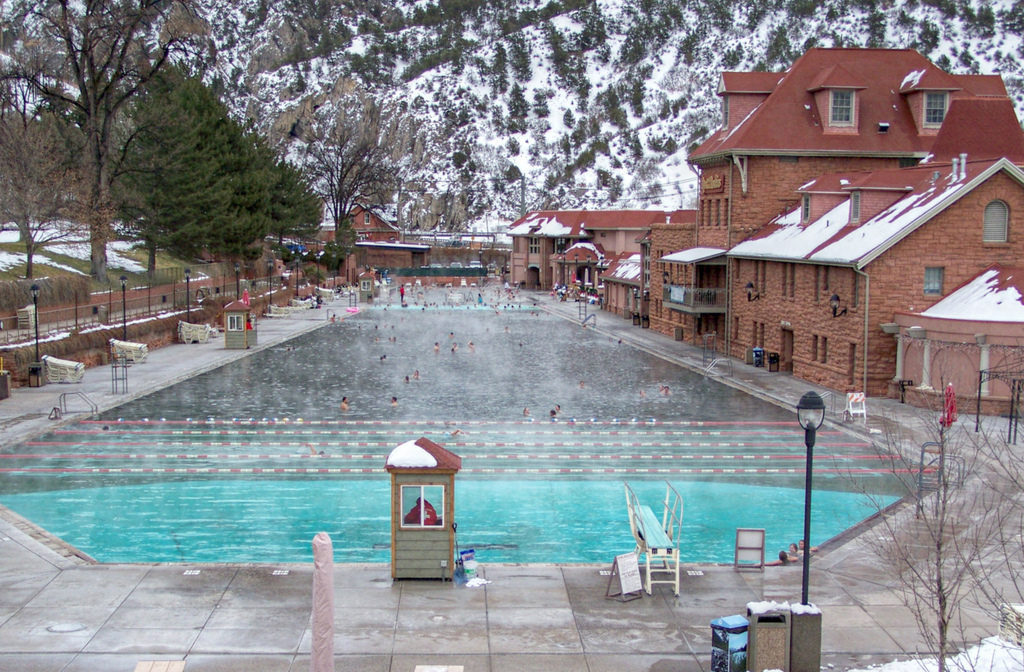
Courtesy of Loco Steve at Flickr
Driving west on I-70, I smell something stinky. Something that reminds me of rotten eggs or sulphur. What is that smell? A few miles down the road, and the answer to my question is evident — Glenwood Springs, Colorado, home of famous hot springs pool, a mammoth hot springs pool.
Large and green, filled with bobbing heads — moms, dads, children and grandparents. The pool is enormous — much bigger than an Olympic sized swimming pools. Some are just wading around or even sitting along the edge, much like you’d sit in a hot tub. Others are actually swimming laps through the green water. All this despite sub-freezing temperatures and snow on the ground.
Colorado is known for its mountains, its skiing, its wilderness — drawing visitors from far and wide. But ever wonder why so many of its towns seemed to have the word “springs” attached to it? Steamboat Springs, Glenwood Springs, Pagosa Springs, Idaho Springs, and the list goes on.
The springs referred to are hot springs, of which there as many hot springs as ski resorts. And on their own, they can be a major draw depending on the community. While the town of Steamboat Springs probably attracts many more tourists for its world-class skiing as for its hot springs, a town about one hour south depends on its hot springs for any kind of visitation.
Hot Sulphur Springs is a tiny community along Highway 40. Most people only know the town because they must drive through it on the way to Steamboat. The Hot Sulphur Springs Resort and Spa has seven natural springs flowing into 21 mineral pools and baths to soak your weary body into. It’s a great reason to not just pass through this town, but spend a night and enjoy the springs.
Glenwood Springs has an entirely large town built around its venerable hot springs. The 400-foot Glenwood Pool has its own resort and lodge, but other hotels in town offer “hot springs” packages as an add-on to a weekend in Glenwood. In fact, Amtrak even has a piece of the action offering a weekend train ride, complete with stays at adjacent hotels to the pool. They’ve created an entire business out of marketing their hot springs.
We as tourists were not the first to discover the soothing nature of hot springs in Colorado. In fact, the Ute Indians discovered the many hot springs and used their healing properties for aches and pains as well. The Ute referred to the large hot springs at Glenwood as Yampah, meaning “big medicine.”
If it’s ruggedness you desire, there are hundreds of hot springs off the beaten path — ones that you have to earn through a backpack or long hike. Conundrum Hot Springs in the Maroon Bells Wilderness requires an 8.5 uphill hike with a 2500-foot gain in elevation. But all that work is rewarded by not only a hot soak, but an amazing view of 14,000-foot peaks soaring above you. Unfortunately, the word has gotten out and summer weekends have become overrun with partying people who are polluting the water. The Forest Service is considering going to a quota system.
Or if complete charm is more your thing, look into the Strawberry Park Hot Springs near Steamboat. What an idyllic spot to get rid of the aches and pains from a hard day’s mountain biking or skiing! The pools are made of stone, and flow from one terrace to the next. Not only that, but due its remote location outside of town, the stargazing is epic as well.
So next time you’re planning a hike, a camping trip, or a longer visit to Colorado, instead of using the run of the mill hot tub at the lodge, look into what nature provides through its geologic processes and find a hot spring to while away the evening.

